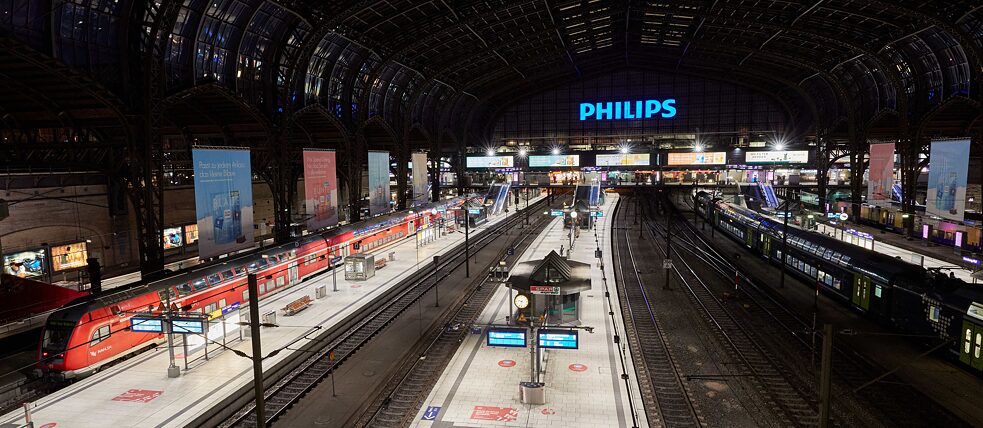Frankly … social
Time, people and the city: two hours before curfew

The main station used to be a hectic place packed with people. But that was before the pandemic struck. Maximilian Buddenbohm has been observing some very different scenes there lately.
By Maximilian Buddenbohm
Two hours before curfew, a little kid is riding in circles on a tricycle at the main station, singing. The parents are standing nearby, chatting and rearranging their luggage. The father hands the mother a newspaper, which she puts in her suitcase. An ordinary family scene. And yet, were it not for the pandemic, it simply wouldn’t be possible, not here, not on a weekday, not at this hour. Back when things were still normal, the main station used to be awfully crowded. It was also the first place in the city to be marked on the ground with the kind of painted arrows for pedestrians that are all over the city centre today. That was way before COVID-19 and it seemed strange to everyone at the time, I still remember people laughing about it. Arrows like that were for cars, they said. Now you were supposed to keep to your lane even when walking, and that was funny. But there were just too many people there: everyone was always in everyone else’s way, constantly pushing and jostling. The building simply wasn’t built for such multitudes; the city, with its millions of inhabitants, had long since outgrown the poky old station. It would have been impossible for a little kid to ride a tricycle in circles inside the station or to be heard singing amidst the crush of rushing people. In those days.
A shaft of sunlight
Not far from the kid on the tricycle, a ray of sunlight is beaming down through the skylights in the station’s steel and glass roof, hitting a narrow spot on the wall between a snack bar and a newsagent’s shop. Both are already closed for the day, which is also unusual. Everything used to be open at this station, almost all the time. A woman is standing in the sunbeam. She’s leaning back against the wall, holding her face up to the evening sun with her eyes closed. She hasn’t got any luggage or shopping with her, you can't tell what she’s doing here at the station. Just standing there sunning herself. And she doesn't seem in a hurry to get anywhere. She has found this ray of sunshine and is savouring it now.I stop and observe these scenes. It was hard to do this sort of thing in the past, to just stand still there. The crowd would have just pushed me aside at this hour of the day. A few people now walk around me: no matter, I’m no bother to them. I watch closely as they pass. I remember how they used to walk, and I'm sure they walk more slowly now. Maybe they’re more relaxed, maybe they’re just more bored. Or after fourteen months of living with COVID-19, maybe they’re exhausted, drained of all energy. I can't tell. But these people are moving at a different pace, in a different pattern. The pandemic has slowed everything down: time, people and the city itself.
People doing nothing
Looking closely, I notice other people sitting or standing around, leaning against a railing somewhere in the station, doing nothing. One man actually does run to catch a train, but he’s the only one moving fast around here – which makes him conspicuous, and some of us follow him with our eyes.Medical supplies are now for sale at a stand where they used to sell newspaper and magazine subscriptions. Face masks, test kits. The saleswoman standing beside the merchandise looks to be in an advanced state of utter boredom, nobody wants to buy her wares. But then a man stops and asks how much for an FFP2 mask. She tells him the price, he laughs, waves her off and continues on his way.
Two men on a bench
Two elderly men are sitting on a bench by the tracks, chatting, holding big paper coffee cups in their hands. Every now and then they push their masks up briefly to take a sip. A suburban commuter train stops in front of them. Some passengers get off, some get on, and the train takes off again. The men are still sitting there, watching all these goings-on. One of them looks up briefly at a few pigeons flying around the station overhead. The display on this track changes to show the next train and departure time. That doesn't interest them, they don't even bother to look. They keep talking: actually, it’s impossible to tell for sure on account of the face masks, but now and then a gesture accompanies the conversation, a nod, a shake of the head. They sit there talking, they seem to have plenty of time on their hands.Maybe that's what you do in a city in which all the usual attractions are closed and almost nothing is going on. Maybe you go to the station, why not, and sit down for a while there, where at least something is still happening, where there are at least some passers-by. And you look around there, where there’s at least a little life, some people and movement around you.
I don't think that’s an odd idea at all. I do it too.
“Frankly …”
On an alternating basis each week, our “Frankly ...” column series is written by Maximilian Buddenbohm, Aya Jaff, Dominic Otiang’a and Magrita Tsomou. In “Frankly ... social”, Maximilian Buddenbohm reports on the big picture – society as a whole – and on its smallest units: family, friendships, relationships.